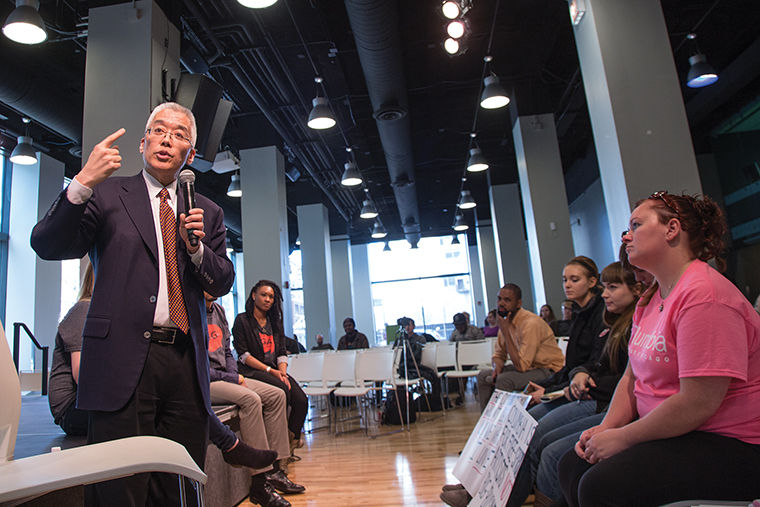Kim addresses Strategic Plan at Pizza with the President
Students had the opportunity to express concerns regarding the college on April 28 during the Student Government Association-sponsored Pizza with the President.
May 4, 2015
Students had the opportunity to dish out their concerns directly with President and CEO Kwang-Wu Kim over a slice of pizza at the April 28 Student Government Association-sponsored Pizza with the President.
The event, held in the Conaway Center in the 1104 S. Wabash Ave. Building, invited students to join Kim in an open dialogue about their concerns, including large class sizes, increasing tuition costs, limiting available student work positions and the Strategic Plan.
KJ Sadural, SGA vice president of Communications and a junior cinema art + science major, said SGA compiled a list of student concerns to ask about the meeting. Kim addressed each topic and answered follow-up questions.
Kim opened the forum by briefly discussing his mission for the college as well as the importance of the Strategic Plan in ensuring the success of the college as a whole.
“My obligation as president is to make sure that the college is operating efficiently and effectively because unless that’s true, we’re not realizing our mission and we’re not serving our students,” Kim said. “There are decisions being made, there’s a plan being proposed, and all of it needs to wrap back to the question: ‘Are these decisions, in the end, going to help us really promote the mission of the college?’”
Kim said the administration is looking at classroom capacity when deciding whether to increase a class’ size. The college’s enrollment has declined by 3,000 students since 2009, and a small increase in class sizes could increase efficiency and reduce costs, he said.
“It’s not just about growth,” Kim said. “It’s about guaranteeing that the quality of the education doesn’t suffer, so it’s a combination of asking faculty if in a classroom of 16 students, does adding one student change the educational experience? Nobody I know wants to lose the quality of small classes.”
Kim said he regrets that the administration did not offer a better explanation of some of its plans, including increasing class sizes.
“We started the work, and the explanation followed, which is never a good way to do things,” he said. “What I’ve realized in my administration is that we need to keep on communicating more regularly and more clearly so that things don’t feel like a surprise.”
Kim also addressed concerns about rising tuition costs, stating tuition increases are directly related to rising costs of the college, including health care benefits for faculty and staff and physical operating costs. Although the tuition increases have remained below the national average, Kim said the college is increasing its funds for need-based scholarships. He said he is also spending time raising money for the college and has secured a new $4 million scholarship fund and a $600,000 fellowship fund in his time at the college.
Matthew Robinson, a senior business & entrepreneurship major, said he was concerned over student-worker compensation and the number of student-worker positions being eliminated due to the forthcoming increase in minimum wage to $10 per hour. Robinson said that after reading that his hours would be cut next year, he has been scrambling to find another job.
“If I were to show you my resume, many of my strongest points come from Columbia,” Robinson said. “Much of my experience in my field has come from here. Since that’s such a crucial part of student success, why isn’t something being done to ensure that students can get enough points on their resumes to take them into their field?”
Kim said that while thinking about next year’s budget, the administration decided not to touch the existing budget for student employment, so the amount of money allocated toward paying student workers will remain the same, rather than increasing to accommodate the minimum wage hike.
“I understand that the increase in minimum wage translates in some cases to a reduction,” Kim said. “We were trying to figure out how to work within what we thought we were going to have for next year.”
Kim said some student worker positions could be untouched depending on how their department created the 2015–2016 budget. He also said that a small percentage of student-worker money comes from Federal Work Study, which the administration is looking into as a potential solution for the student employment budget.
Federal Work Study is a program that provides part-time jobs for students with financial need. The college’s tentative award from the Federal Work Study Program for the next fiscal year is $683,000, and students can receive a maximum of $5,500 in an academic year through the program, as reported March 16 by The Chronicle.
Other students also expressed dissatisfaction with the diversity, equity and inclusion portion of the Strategic Plan.
“Multicultural Affairs is not listed once,” said Adrian Azevedo, a senior theatre major. “How do we get the MCA office specifically in [there] and use the resources that we have to push the things that were already in place?”
Kim said although the Strategic Plan is in the final approval stage, it will be continually revised in conversation with the community. He also said there will be an ongoing standing committee that will review the success of the plan.
“Success in strategic planning is not just ‘Well, we did what we said we were going to do, so we’re successful,’” Kim said. “It’s actually, ‘We did what we said we were going to do, does it make any difference?’”
Kim and Sara Kalinsoki, SGA president and an art and materials conservation major, said the event was a success, bringing attention to many of the issues that students felt were important to the college.








